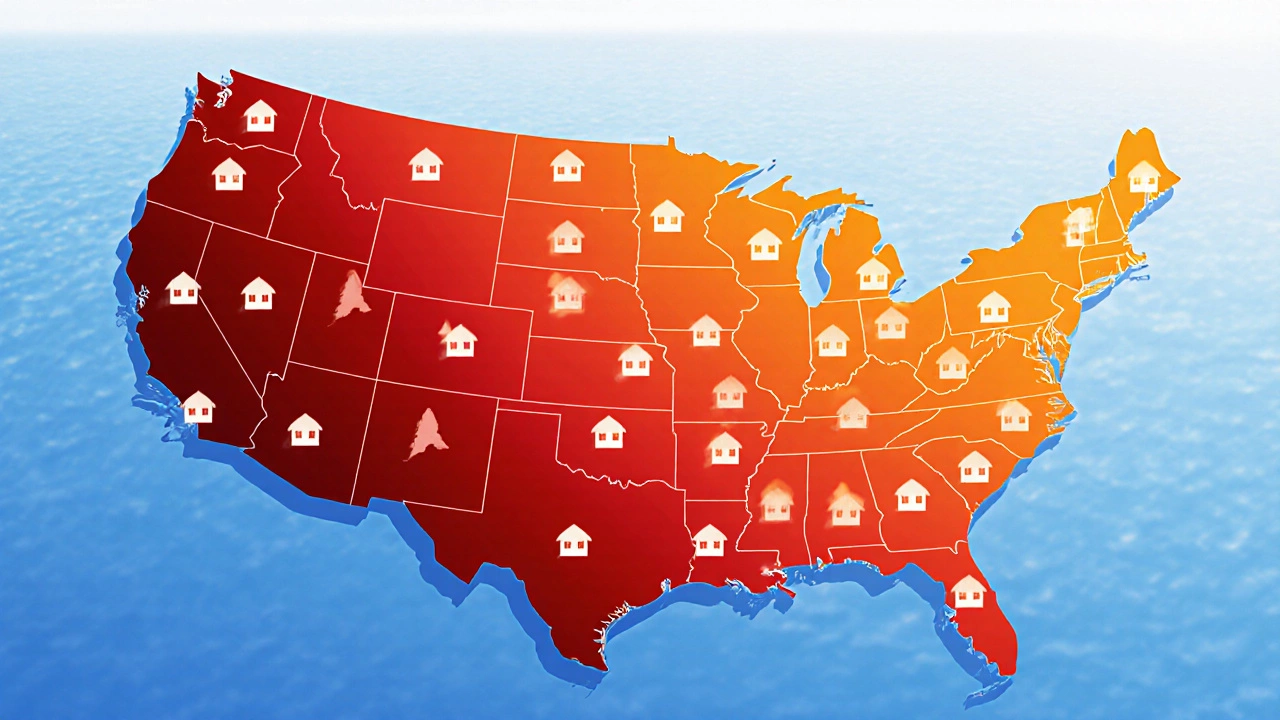Home Affordability Calculator
Estimate your home affordability based on current market conditions. Enter your annual income, target home price, and local property tax rate to see if you can comfortably afford a home.
Affordability Score
Monthly Mortgage Estimate
Key Metrics
Your Situation
Ever wondered why some states feel like a maze when you try to buy a home? The answer isn’t just about high prices-it’s a mix of income gaps, inventory crunches, taxes, and even local lending trends. In this guide we break down exactly which U.S. state tops the difficulty chart in 2025, how the rankings are built, and what you can do if you’re eyeing a property there.
How We Measure Buying Difficulty
To keep things transparent, we scored each state on five key pillars that directly affect a buyer’s ability to close a deal:
- Median Home Price vs. Median Household Income - The classic affordability test.
- Housing Affordability Index (HAI) - Published monthly by the National Association of Realtors. An HAI below 100 means a median‑income family can’t afford a median‑priced home.
- Inventory Levels - Measured as months of supply; less than four months signals a tight market.
- Property Tax Burden - Effective tax rates that eat into monthly mortgage payments.
- Average Mortgage Rate - When rates climb, buying power shrinks.
Each pillar received a score from 1 (easiest) to 10 (hardest). We then added the scores and ranked the states. The data pull comes from the Zillow housing database, the U.S. Census Bureau, and the Federal Reserve’s latest mortgage reports.
National Snapshot - 2025 Housing Landscape
Before zooming into the toughest markets, let’s see the big picture. In 2025 the Median Home Price nationwide sits at $420,000, up 7% from last year. Meanwhile, median household income grew only 3%, creating a widening gap.
The Housing Affordability Index fell to 112, down from 119 in 2024, meaning fewer families can comfortably afford a home. Inventory remains low - about 3.6 months of supply - and the average 30‑year fixed mortgage rate hovers around 6.8%.
These macro trends set the stage for a few hot spots where the math gets especially unforgiving.
Top 5 Hardest States to Buy a House in 2025
| State | Median Home Price | Median Household Income | HAI | Months of Supply | Effective Property Tax % |
|---|---|---|---|---|---|
| California | $780,000 | $95,000 | 92 | 2.8 | 0.76% |
| New York | $680,000 | $88,000 | 95 | 3.1 | 1.02% |
| Massachusetts | $620,000 | $85,000 | 98 | 3.0 | 1.12% |
| Washington | $620,000 | $90,000 | 99 | 2.9 | 0.93% |
| Colorado | $560,000 | $82,000 | 101 | 3.2 | 0.79% |
These five states consistently scored 8‑10 across all five pillars, making them the toughest arenas for would‑be homeowners.

Why These States Are So Tough
Let’s unpack the underlying forces that push these numbers to the extreme.
- Sky‑High Prices - California’s median home price tops $780K, driven by tech‑industry wages (which are unevenly distributed) and limited land in coastal metros.
- Stretched Incomes - Even though some residents earn six‑figure salaries, the median household income lags behind price growth, especially in New York’s upstate‑urban split.
- Low Affordability Index - An HAI under 100 tells you a typical family would need to allocate over 30% of gross income to housing, breaching the conventional 30% rule.
- Inventory Shortage - All five states sit under three months of supply, meaning buyers are often in bidding wars.
- Tax Pressure - Massachusetts and New York levy property taxes above 1%, inflating the monthly cost base.
- Mortgage Rate Sensitivity - With rates near 7%, the qualifying income threshold rises sharply, squeezing first‑time buyers.
Combine those factors, and you get a perfect storm where even well‑qualified buyers get edged out.
Tips for Buying in the Hardest Markets
If you’re set on one of these states, don’t throw in the towel. Here are proven tactics that can tilt the odds in your favor.
- Boost Your Down Payment - A 20%+ down reduces loan‑to‑value ratios, making lenders more comfortable and lowering monthly payments.
- Leverage Local Assistance Programs - Many metros offer first‑time‑buyer grants, reduced‑rate loans, or tax credits. California’s “CalHFA” and New York’s “SONYMA” are worth a deep dive.
- Expand Your Search Radius - Suburban or ex‑urban pockets often have better price‑to‑income ratios. In Washington, looking beyond Seattle’s immediate suburbs can shave $100K off the price tag.
- Get Pre‑Approved Early - A solid pre‑approval signals seriousness and can win you a contested offer.
- Consider a Co‑Buyer - Pooling incomes can meet affordability thresholds without over‑stretching.
- Stay Flexible on Timing - Seasonal slow‑downs (typically winter) see fewer buyers, reducing competition.
These strategies don’t guarantee a win, but they dramatically improve your chances compared to going in blind.

Quick Checklist - Is Your Target State Too Hard?
- Median home price > 6× median household income?
- Housing Affordability Index below 100?
- Months of supply under 3?
- Effective property tax rate > 1%?
- Current mortgage rate > 6.5%?
If you answered “yes” to three or more, you’re likely in one of the hardest markets. Use the tips above or consider adjacent states where the same lifestyle can be enjoyed at a lower price point.
What the Future May Hold
Market dynamics evolve. Looking ahead, a few trends could ease the pain:
- Housing Supply Initiatives - California’s recent zoning reforms aim to add 1.2 million units by 2030.
- Interest‑Rate Volatility - If the Federal Reserve trims rates later this year, buying power could rebound.
- Remote‑Work Flexibility - As companies stay hybrid, buyers may relocate to lower‑cost counties while keeping high‑salary jobs.
Keep an eye on these signals; they often dictate when the market softens enough for a more reasonable entry point.
Which state has the highest median home price?
California leads with a median home price of about $780,000 in 2025, driven by tech‑centered demand and limited coastal land.
Is a 30% income‑to‑housing ratio still a good rule?
It remains a solid benchmark. When the ratio exceeds 30%, households often struggle with other expenses, especially in high‑tax states.
How can I find local buyer assistance programs?
Start with state housing agencies (e.g., CalHFA, NY State Housing Finance Agency) and city‑level community development offices. Many list eligibility criteria and application steps online.
Do mortgage rates affect affordability more than home prices?
Both matter, but a 1% rate jump can offset several thousand dollars of price reduction. In tight markets, a higher rate widens the affordability gap faster than price changes.
Should I consider renting instead of buying in these states?
Renting can be a smart short‑term move while you save for a larger down payment or wait for inventory to improve. Compare rent‑to‑price ratios; if renting costs less than 30% of a comparable home’s mortgage, staying flexible may preserve cash.

